Top News
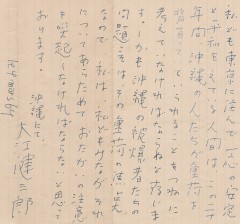
August 6, 2014 Mamoru Yasuda of Ryukyu Shimpo
Nobel Prize-winning author Kenzaburo Oe wrote a book about Okinawa titled Okinawa Notes. He has deep emotional ties to the prefecture. When he visited Okinawa for the first time in 1965, Oe met Okinawan atomic bomb survivors, and wrote a memoir directed at them.
In the handwritten memo, Oe said, “We have to always recognize about Okinawan people having to bear burdens.”
In the memorial, Oe describes himself as a someone who lives in Tokyo in an environment that is secure and peaceful compared to Okinawa. He pointed out that Okinawan atomic bomb survivors were clear evidence of the disproportionate burden inflicted on Okinawan people. Oe went on to say, “We need to be aware of that fact.”

Kenzaburo Oe
On March 4, 1965, Oe met Okinawan atomic bomb survivors in Naha. Ninety-year old Tsuruko Makishi, who spoke of her experiences as a victim of the atomic bomb in Nagasaki to Oe, asked him to write down his response to it as a record.
Oe did not release his writing to the public for about half a century. It is a sentimental and valuable memorial that is sympathetic to the Okinawan people. It is written by a person who has continued to remember atomic-bomb victims.
Right after Oe visited Okinawa, he published his first essay about Okinawa in monthly periodical SEKAI (The World) and described what he and Makishi talked about. In Hiroshima Notes which was published in the same month, Oe referred to the meeting with Makishi in a prologue, and wrote about the suffering of Okinawan atomic bomb survivors.
Around that time, Okinawa was under U.S.military administration. The administration did not take care of Okinawan atomic-bomb survivors. Even though the Japanese government put in force an Act for Atomic Bomb Sufferers’ Medical Care, it was not applied to Okinawan people.
A survey on Okinawan atomic-bomb survivors started in September 1963.
The World Conference Against Atomic and Hydrogen Bombs was held in Hiroshima in August 1964.
At the conference, Okinawan atomic-bomb survivors talked about the issue.
On August 3, Oe talked about his memorial to Ryukyu Shimpo. He said, “I have never forgotten writing that memorial in front of Okinawan people when I was young. Even into my elderly years, I have not stopped thinking of the difficulties that Okinawa faces. I will continue to remind myself that I have not done enough for Okinawan people.”
(English translation by T&CT)
Go to Japanese
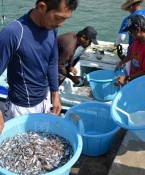
August 1, 2014 Ryukyu Shimpo
On July 27, which is July 1 in the lunar calendar, on Ojima Island, Tamagusuku, Nanjo, fisherman brought in their annual bonus catch of young rabbitfish, called suku in Okinawan language.They returned from the sea in the early morning, carrying baskets filled with tiny silver fishes. The bonus catch came later than usual this year, and was not as big.
The islanders of Ojima call the catch of young rabbitfish a “Summer bonus from the sea,” because they fish for suku for a few days before or after June 1 and July 1 in the lunar calendar. Before and after June 1 this year, they went for fishing. However, they did not catch the fish.
As of 9:30 a.m. on July 2, they caught about 44 kilograms of suku. The fishermen said that they had caught more suku last year than this year. However, they looked relieved to have caught some suku despite it being a small catch.
Women measured suku fishes and sold them at the market.
Sayuri Urasaki, who works at a fish store in the market said, “It is better than nothing. But fishermen need to catch more than 300 kilograms of suku to earn bonus.”
(English translation by T&CT, Hitomi Shinzato)
Go to Japanese
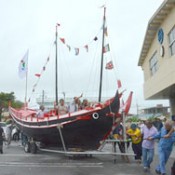
August 5, 2014 Ryukyu Shimpo
A wooden sailboat called Maransen was restored for the first time following the Battle of Okinawa. The sailboat was presented to residents at Henza public hall in Uruma City on July 31. A presentation ceremony was not held due to the effect of typhoon No. 12. However, many residents celebrated the newly-restored Maransen by performing Kachashi dance amid cheers from fishermen, and the sound of gongs and drums.
Sixty-year-old boat builder Haruki Goeku, who works at Henza, and three assistant boat builders, including Goeku’s son Yuki, 32, restored the traditional sailboat. At the ceremony, Uruma City Mayor Toshio Shimabukuro presented a letter of appreciation to them. Tatsuki Iha, a second-grade student of Ayahashi Junior High School named the boat “Kisinmaru.” He said, “I want the sailboat to be a symbol of travelling towards hope.”
Uruma City Office plans to invite people to an embarkation experience on August 16 and 17. After that, the boat will be open for viewing to the public. Mayor Shimabukuro said, “We would like to make use of the Maransen to educate society and the local community through its exhibition program.”
(English translation by T&CT)
Go to Japanese
August 7, 2014 Ryota Shimabukuro of Ryukyu Shimpo reports from Washington D.C.
According to a list of Class A mishaps published by the U.S. Naval Safety Center, a U.S. Marine MV-22 Osprey aircraft was struck by lightning on June 27. A Class is the most severe type of accident. On August 5, the Okinawa Prefectural Government (OPG) asked for information on this mishap to the Marine Corps through the Okinawa Defense Bureau. The OPG received the following answer; the aircraft had been struck by lightning while parked on the Futenma base. The OPG’ officials commented that they would not consider further requests as of yet, because it was not an accident during flight.
The safety center says it is believed that the aircraft was struck by lightning while flying from Marine Corps Air Station Iwakuni in Yamaguchi to Futenma on June 27.
The safety center classifies aircraft accidents such as Class A, B and C. A Class A is an incident in which there is total cost of damage greater than $2 million (about 200 million yen).
(English translation by T&CT)
Go to Japanese

July 30, 2014 Akiko Agarie of Ryukyu Shimpo
With the aim of deepening exchanges and bringing good cheer through Okinawan new dance culture, members of the Okinawa Yui Dance Promotion Council visited Mazhuancun in Xuzhou, Jiangsu province, China, on July 29. Including Chairman Kiyoshi Miyagi, six members of the council put on a dance lecture workshop for people of Mazhuancun, and held a discussion meeting with the local government officials.
As part of the dance lecture, the council’s members taught local people rhythmical, flexible hand movements, to the theme song of Okinawa Yui Dance Iyasassa Mourana.
At a discussion meeting, the members introduced Okinawan history, in which Okinawa exchanged with China during the Ryukyu Dynasty. They also discussed the Battle of Okinawa and lifestyles that support longevity. Qingxi Meng, who is Secretary of Mazhuancun, said, “We might be linked with Okinawa by fate because they came all the way here. Next time, we would like to visit Okinawa and interact with local people. We hope to set up a friendly relationship by visiting each other.”
On September 13, a dance event titled the 4th Iyasassa Mourana in Uruma will be held at Ishikawa Kaikan in Uruma. Dancers from Mazhuancun will also take part in the event.
(English translation by T&CT and Lima Tokumori)
Go to Japanese
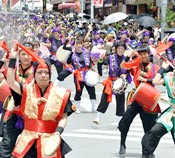
August 4, 2014 Ryukyu Shimpo
Ten Thousand Eisa Dance Parade was held in the 20th Summer Festival on Kokusai Street in Naha. With great vigour and energy, the participants performed Okinawan traditional performing arts such as eisa dance and creative dance on the road. The crowd of spectators enjoyed it.
Celebrating the summer season, the sound of the drums echoed on the street under blue skies.
About 30 eisa organizations as well as eisa groups which unofficially took part in the festival, and local youth associations performed eisa while parading through 10 locations from Saion Square in Asato to Palette-Kumoji.
Supporters of eisa performers sprinkled water on drummers at each performing location to prevent heat stress disorder.
(English translation by T&CT)
Go to Japanese
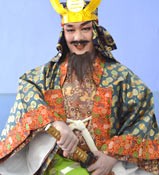
August 4, 2014 Ryukyu Shimpo
Two South American students of Okinawan descent, whose roots are in Yonabaru Town, took part in the Yonabaru Great Tug-of-War at the Udun-yama Youth Square in Yonabaru Town on July 27.
Sebastian Pablo Uehara who is from Argentina, took part as shitaku, a person dressed in costume who stands on the rope. This year he was dressed as Takaraderauzashi in kumiodori play Manzaitechiuchi.
Caren Chiemi Uehara Gushiken took part in the challenge of memoi song and dance, which set the mood for the michijune parade and the tug-of-war.
Pablo whose great-grandfather is from Yonabaru, and Gushiken whose grandfather is also from the town, visited Okinawa for the first time on July 23 for a study project for children of Okinawan emigrants. The town runs the project.
This is the second time foreign students of Okinawan descent have taken part in the tug-of-war.
While staying at their relatives’ houses for three months, the two students plan to learn Japanese, sanshin, pottery, Japanese Calligraphy, and karate in Yonabaru.
Uehara said, of taking part in the tug-of-war, “When my great-grandfather emigrated to Argentina, he must have regretted that he was far from Okinawan traditional culture. I am glad that I had the chance to continue our traditions through this project.”
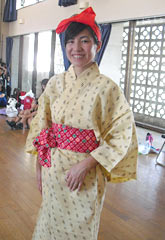
Caren Chiemi Uehara Gushiken took part as one of memoi dancers who introduced the tug-of-war in Yonabaru on July 27 (Photograph provided by the town).
Gushiken said, “I am impressed that all the residents were united in their work on making the event successful, from creating ropes to holding the tug-of-war.”
Uehara said, “Even though I was a bit worried about the project because I had to study a lot, I would like to tell others what I felt from the event after I come back to home.” He went on to say, “I would like to make a go of an event of the Yonabaru Association of Argentina to commemorate the 65th anniversary of its founding next year.”
The Yonabaru Association of Peru, which re-creates the great tug-of-war, marks the 100th anniversary of its founding this year. Gushiken said, “I would like to teach the memoi dance that I learned here, to the association, and entertain the association members.”
(English translation by T&CT)
Go to Japanese
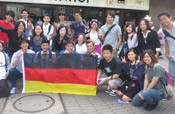
July 31 2014 Ryukyu SHimpo
Under the theme of “Plant Okinawan seeds in Europe,” the third World Youth Uchinanchu Festival Germany 2014 was held in Dusseldorf from July 30 to August 1. Young people of Okinawan descent took part from all around the world. The event drew 38 participants from Germany, the United Kingdom and France. Before the opening ceremony, the participants took part in a sightseeing tour of the city, and interacted with one another.
Riki Arakaki who is from Naha and currently studying in the United Kingdom, said, “It was interesting to join the festival aimed at young people from the same generation. I realized the charm of Okinawa which can be seen clearly from outside the prefecture. I am looking forward to meeting other participants.”
For the opening ceremony on July 31, stage performances of Ryukyuan dance and sanshin were held. In the afternoon, organizers held a talk session named “Baton of Memories of War and Peace.”
On August 1, organizers held an event, in which participants introduced Okinawan cultures that take root in various countries and regions all around the world. The event named “International Yuntaku Cafe,” in which the participants chatted with one another in a relaxed manner.
(English translation by T&CT)
Go to Japanese

July 31, 2014 Ryukyu Shimpo
The Okinawa Institute of Science and Technology (OIST), based in Onna, has founded its first venture company Okinawa Protein Tomography Ltd. (Okinawa PT). The company headed by CEO Akira Kamei was founded on June 25. It commenced business at the start of August. The company has exclusive rights to the use of a technology that enables visualization of protein structures in three dimensions. This technology is the only of its kind in in the world, and was developed by Professor Ulf Skoglund of the OIST Structural Cellular Biology Unit. The company will accept orders for analysis of protein such as molecular structure required for new drug development from pharmaceutical companies. This technology is an effective way to analyze the structure of protein. The company aims to carry out diagnostic business and drug discovery in the future.
Usually the method of X-ray crystal structure analysis is used to analyze the structure of protein. However, crystallization of proteins is time-consuming and expensive. The method developed by Professor Skoglund can restore the structure of the protein in the three-dimensional world without crystallizing the samples. This method comprises taking pictures of the samples by rotating 281 times at various angles with an electron microscope and then carrying out image processing by separating the noise by using a PC program originally developed in order to restore the structure in the three dimensions. It can identify up to about 1.5 nanometers (one millionth of a millimeter).
Professor Skoglund emphasized the significance of this technology, saying, “This is the only one technology of its kind in the world. It can help the development new drug. It will also provide opportunities for the pharmaceutical companies of Japan.”
(English translation by T&CT)
Go to Japanese
August 2, 2014 Ryukyu Shimpo
Environmental groups in Japan and the United States and the plaintiffs of the Okinawa dugong lawsuit filed a new action with the San Francisco Federal District Court on July 3. The National Historic Preservation Act (NHPA) of the United States requires the government to protect cultural heritage around the world. Based on this law, the plaintiffs requested that U.S. government should take action to protect the dugong as an endangered species. The Okinawa Defense Bureau is carrying out work to build alternative facilities for U.S. Marine Corps Air Station Futenma at Henoko. The U.S. military has rights to administrate Camp Schwab based on the Status of Forces Agreement between Japan and the United States. The lawsuit aims to force the Defense Ministry of the United States to have to stop Japanese workers and vehicles employed by the Okinawa Defense Bureau from entering Camp Schwab.
The plaintiffs filed the Okinawa dugong lawsuit in 2003. In a tentative ruling in 2008, the judge decided that the dugong is subject to the NHPA, and that not evaluating the impact on the dugong was a violation of the law. The plaintiffs hoped that the U.S. defense ministry would respect the requirements of the National Historic Preservation Act, decided by this initial judgment. The case was suspended after the judge’s decision. It will be resumed under a complaint issued by the plaintiffs. The court is expected to make a ruling on the case within 5-6 months, which is the shortest possible period.
In April, the U.S. defense ministry argued there was not an adverse effect on the dugongs according to a report they submitted to the federal district court. At a press conference, the plaintiffs pointed out that consultation with the peoples concerned, including the plaintiffs is not enough because it does not meet the necessary procedures of NHPA. They questioned why the documents created by the U.S. expert special committee were not disclosed. The plaintiffs asked the government to reveal the documents.
Anna Shimabukuru, a plaintiff who was born and raised in Nago City, said, “The sea is the property of the world. We want to strive to make Okinawa a peaceful place in the future.”
Takaaki Kagohashi, the head of the plaintiff attorneys and representative of the Japan Environmental Lawyers Federation, showed that a survey group of trained volunteers confirmed 118 traces of dugongs eating seaweed in sea grass beds of Schwab during May-July. He pointed out, “The Okinawa Defense Bureau has not reported this fact in the environmental impact assessment. There is conclusive evidence of Dugong feeding grounds beneath the site where the airfield will be built. There is a fair possibility the U.S. court will find the government has neglected to follow the basic procedures of the NHPA in the hearing of the case.”
(English translation by T&CT)
Go to Japanese
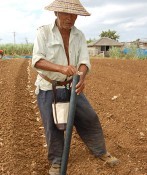
July 31, 2014 Yukito Kinjo Correspondent of Ryukyu Shimpo
On a severely hot day at a field in Nishieue, Ie Village, an elderly person works silently to plant shima rakkyo. Yoshio Yamashiro from Nishieue is 94 years old, born in 1920. He has weak hearing, but he is robust with a straight back and lots of stamina. He is a cheerful old man who drives a car around the village.
On April 16, 1945 when the U.S. military landed on Ie Island, Yoshio (24 years old at that time) was helping courtesy for a leader of the unit of the Japanese Imperial Army. Having lost his first daughter and friends in the war, he does not talk much about it. Every year, on April 21, the day the war ended at the village, a peace memorial service is carried out at the war memorial. Representing the Village’s War-Bereaved Association, Yamashiro will offer flowers to fallen comrades.
As well as farming, Yamashiro takes care of his 94-year-old wife Midori, and does housekeeping such as cooking, laundry, and cleaning.
To plant shima rakkyo, Yamashiro bends over to put seeds deeply in the soil by hand. This work has put strain on his back. A couple of days ago, he came up with an idea to use a pipe for planting. Hanging a seed-bag on his waist, he dropped seeds down the tube. Then he drove a tractor over the area to cover the seeds with soil. He said with a confidence, “Many people become confined to their beds at my age. It’s only me who does farming.”
Nishieue Ward Leader Kunio Chinen said, “Every time I see him, he is giving water or does weeding at his field. He is such a hard worker. I wish young people to follow that.”
Yamashiro in a kubagasa and usual work clothes said with a smile on his face, “It is a lot of work to take care of this entire field. It will take until tomorrow to finish.”
(English translation by T&CT and Megumi Chibana)
Go to Japanese











 Webcam(Kokusai Street)
Webcam(Kokusai Street)


